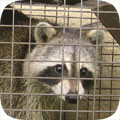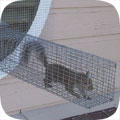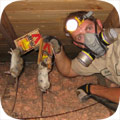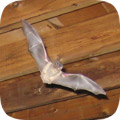- aspenhill@wildlifeanimalcontrol.com
Call 24/7 for a free quote:
240-428-6370
Aspen Hill Wildlife Animal Control
Professional Wildlife Removal Company Servicing Aspen Hill, MD
If you have a problem with wildlife in your Aspen Hill home, your best option is to hire a company that specializes in Maryland wildlife removal only. This is a specialty business, and regular pest control companies do not use the proper techniques to solve animal problems. I have spent many years reviewing Maryland and Aspen Hill, and I recommend the following:
District Wildlife Solutions
Cell Phone: 240-428-6370
NOTE: If you have a dog or cat problem, call Montgomery County Animal Services: 240-773-5900

District Wildlife Solutions specializes primarily in removing animals from attics of homes and buildings - this includes squirrels in attics, raccoons, and rats or mice in homes. Maryland also has a documented problem with
bats in buildings, and District Wildlife Solutions is specially trained in bat removal. They also perform general wildlife trapping services, such as the capture and removal of skunks or opossums on the
property. Call 240-428-6370 to discuss your critter problem and schedule a same-day or next-day appointment. Click here to learn more about what prices we charge in 2020.
When hiring a company to solve your wild animal problem, you want these features:
- Specializes in wildlife removal, not pest control
- Fully Maryland and Montgomery County licensed and insured
- Works 7 days per week (critters don't take weekends off)
- Performs full building inspections: enters and inspects attic
- Performs exclusion repairs, with guarantee against animal re-entry
- Offers cleanup of biohazardous wildlife waste
District Wildlife Solutions is a full-service Aspen Hill wildlife removal company. This is very different from a regular Aspen Hill pest control company. The pest control companies spray poison to kill insects. This is not at all
similar to wildlife removal. District Wildlife Solutions performs a full inspection of the home or property, and determines why the animal(s) are there, and if inside a building, how the animals got inside. All
animals (including rodents) are trapped and removed, or if possible, removed from the building using special exclusion devices. Once the animals are gone, preventative repairs are essential, and
cleanup is sometimes recommended.
 Aspen Hill wildlife trapping - it's not as simple as it may seem. It's illegal in Maryland to trap without a license. Trap type is very important and there are many different types, bait is somewhat relevant, trap placement
is vital, and there are dozens of small things that are very important to know.
Safety is a concern. Then once the animal is trapped, it must be removed and dealt with in the proper manner according to Maryland law. We offer Aspen Hill raccoon removal. Read more about how to get rid of raccoons.
Aspen Hill wildlife trapping - it's not as simple as it may seem. It's illegal in Maryland to trap without a license. Trap type is very important and there are many different types, bait is somewhat relevant, trap placement
is vital, and there are dozens of small things that are very important to know.
Safety is a concern. Then once the animal is trapped, it must be removed and dealt with in the proper manner according to Maryland law. We offer Aspen Hill raccoon removal. Read more about how to get rid of raccoons.
 Animals in attics - this is our specialty at District Wildlife Solutions. Many types of animals like to live in attics. This includes squirrels, raccoons, rats, mice, bats, birds, and even possums. Critters like to go into attics for a safe place to live
and raise their young. Removing animals from attics is very complex work, partly because of the presence of baby animals. If you need Aspen Hill squirrel removal, we can remove all the squirrels from your attic, and seal out any future ones. Read more about how to get rid of squirrels.
Animals in attics - this is our specialty at District Wildlife Solutions. Many types of animals like to live in attics. This includes squirrels, raccoons, rats, mice, bats, birds, and even possums. Critters like to go into attics for a safe place to live
and raise their young. Removing animals from attics is very complex work, partly because of the presence of baby animals. If you need Aspen Hill squirrel removal, we can remove all the squirrels from your attic, and seal out any future ones. Read more about how to get rid of squirrels.
 Rodent control must be done in a very specific way. First off, the most important thing is that all the openings that rats and mice can use to enter a house be sealed. Then all the rodents must be physically trapped and removed.
Never, ever use poison! Most Aspen Hill exterminators will just use this lazy poison technique to kill rodents, and it causes more harm than good - dead stinky rats, and it doesn't solve the problem. Call us for correct Aspen Hill rat removal. Read more about how to get rid of rats.
Rodent control must be done in a very specific way. First off, the most important thing is that all the openings that rats and mice can use to enter a house be sealed. Then all the rodents must be physically trapped and removed.
Never, ever use poison! Most Aspen Hill exterminators will just use this lazy poison technique to kill rodents, and it causes more harm than good - dead stinky rats, and it doesn't solve the problem. Call us for correct Aspen Hill rat removal. Read more about how to get rid of rats.
 Bat removal is a highly specialized task. Maryland is known to have colonizing bats who often live in buildings. Bats love attics. If not removed, the colony can grow to a very large size over the years. The bat droppings are often corrosive and
cause health risks. The same goes for bird droppings on or in buildings. We perform Aspen Hill pigeon removal and bird control. But our specialty is Aspen Hill bat removal. We remove 100% of the bat colony and seal the building so that it's totally bat-proof. Read more about how to get rid of bats.
Bat removal is a highly specialized task. Maryland is known to have colonizing bats who often live in buildings. Bats love attics. If not removed, the colony can grow to a very large size over the years. The bat droppings are often corrosive and
cause health risks. The same goes for bird droppings on or in buildings. We perform Aspen Hill pigeon removal and bird control. But our specialty is Aspen Hill bat removal. We remove 100% of the bat colony and seal the building so that it's totally bat-proof. Read more about how to get rid of bats.
 If you have animals inside a house, no job is complete without proper exclusion repairs. If you simply hire a Aspen Hill trapper who only removes the critters, then the problem will return. You need to hire a Aspen Hill wildlife control company that identifies 100% of the animal entry points
into your building, and seals them shut with professional repairs. In addition, in many cases animals have left waste or contamination behind, and you'll want a company that can provide professional cleaning services. District Wildlife Solutions does both.
If you have animals inside a house, no job is complete without proper exclusion repairs. If you simply hire a Aspen Hill trapper who only removes the critters, then the problem will return. You need to hire a Aspen Hill wildlife control company that identifies 100% of the animal entry points
into your building, and seals them shut with professional repairs. In addition, in many cases animals have left waste or contamination behind, and you'll want a company that can provide professional cleaning services. District Wildlife Solutions does both.
The above are just some of the services offered by District Wildlife Solutions. We also trap and remove animals that destroy lawns, such as moles, or digging animals. Sometimes animals like opossums will live under buildings, steal pet food, raid garbage cans, etc.
Read about how to get rid of opossums. Skunks commonly live under sheds or decks, and set up a den. We can trap and remove them without them spraying. Read about how to get rid of skunks. District Wildlife Solutions
also provides dead animal removal in Aspen Hill. If you need help with any other wildlife conflict, from a fox, beaver, groundhog, or any other critter, we can solve it. We also do Aspen Hill snake removal - most of the snakes in Maryland are not venomous, but
call us if you want safe removal, or read about how to get rid of snakes in Aspen Hill. And remember, we are a private business, not Montgomery County Animal Control Services, so if you have a dog or cat problem, call the County at 240-773-5900.
Montgomery County animal services does not handle any wildlife issues.
District Wildlife Solutions: 240-428-6370
Aspen Hill Pricing Info For Year 2020
 Every wildlife removal situation is different, from the species of animals involved, the location of the animal inside a house or outside, the extent of repairs or cleanup, etc. It's impossible to give one-size-fits-all prices. Examples MIGHT include:
Every wildlife removal situation is different, from the species of animals involved, the location of the animal inside a house or outside, the extent of repairs or cleanup, etc. It's impossible to give one-size-fits-all prices. Examples MIGHT include:
Small Job: For example, a one-stop job to remove an animal in the yard: $100 on up
Medium Job: For example, getting critters out of your house with minor repairs: $300 on up
Large Job: For example, a project involving many service trips and complex work: $500 on up
Give us a phone call now and tell us about your wildlife issue and we will be able to give you a price estimate over the phone. If you're cool with it, we can schedule a same-day or next-day appointment if you like. Our prices are fair, and a good value because we do the job right, the first time.
Aspen Hill Wildlife Tip #1:
How To Trap A Rabbit
Rabbits play a very important role in the society. They;
1. Provide hunters the chance for sport when they go hunting,
2. They are eaten and also,
3. Can get sold for monetary gain.
This, however, is only the bright side about the tiny creatures. Despite all that, rabbits, wild rabbits mostly, are small menaces to our gardens and vegetables. They are also potential carriers of some deadly diseases which could actually be communicated to humans too. This therefore, being a real and disturbing problem, needs to be solved. There are very many ways of keeping rabbits off of private property, especially a garden. Some of the ways include;
1. Fencing- by use of either mesh or an electric fence.
2. Use of repellents, like blood scent, wolf urine, pepper and garlic.
3. Actually having a predator, like a dog, in your home.
4. Strategically planting some plants that naturally repel rabbits, like onions, germanium and catnips.
The other means that could be employed is trapping the rabbits, and getting rid of them. The best way to get rid of them is by releasing them far away from the compound we don't want them invading, preferably five or more miles away. However, before deciding to take this step, it is best that one checks with the local authorities least one gets them into trouble. Trapping of rabbits is definitely a science in itself, although it is not that much complicated.
Identifying the best trap.
The traps available for rabbit trapping use either the one-door or the two-door technique. These techniques are named by how many doors the traps have. The one door trap technique comes highly recommended by professionals since its design attracts the rabbit further into the trap and thus guarantees more success per attempt. The two-door technique on the other hand, has two doors and thus;
1. Has a higher catch rate,
2. Can be used both as a one door and as a two door trap.
The ability to see through the trap gives anxious animals a little more confidence to venture into it and thus increases the chances of success.
Snare traps are also used with rabbits, but it is best that their use is minimized since they could end up killing the poor creatures and that is not a very humane method of dealing with the rabbit problem.
Identifying where the rabbits frequent.
The first thing one needs to is to spot where rabbits are most easily found. They are very fond of areas with a lot of vegetation cover, mostly for protection since they have such a wide range of predators. It is therefore very rare to find them crossing wide stretches of open land since there are naturally very precautious animals. They are however very fond of transitional regions, which are regions between two differently structured landscapes, like where cover meets open space. If you spot a rabbit's habitat, like a burrowing point or such, then you should place a trap nearby, to increase your chances and your catch rate.
Bait.
Rabbits are herbivores so it goes without saying that the best bait for rabbits is either a vegetable, or a fruit. The easiest way to select a bait in your garden, is by identifying what the rabbits appear to eat up the most in your garden and using that. However, if that proves difficult, there are other universal rabbit baits that one can use. They include apples, carrots and potato peelings. In winter, it is best to avoid bait with a lot of water since the water could freeze. In such situations, dehydrated baits are best for the job.
Trap placement.
This is the last part of the whole thing, and is just as important as the rest. The trap should be set in such a way that, the least application of force triggers it to be able to respond fastest and best to the rabbit's presence. However, in case the rabbit is expected to be too light to trigger the trap, then the trap could be reinforced with a little weight by use of something like a rock, to increase its sensitivity. The trap should also be handled very carefully, preferably with gloves to avoid presence of human's scent in the trap which could scare rabbits away from the trap.
Wild rabbits also carry harmful diseases with them that are communicable to humans, so they should be handled very carefully, and should not be domesticated.
Aspen Hill Wildlife Tip #2:
Maryland Wildlife Information:
Maryland State bird: Baltimore oriole
State mammal: Thoroughbred, calico cat, Chesapeake Bay retriever
State reptile: Diamondback terrapin
State fish: Striped bass
State insect: Baltimore checkerspot butterfly
Maryland is one of the most diverse states in the country, and it is so unique in its variety of habitats, it has been dubbed "America in miniature". This nickname is due to the fact the state has sand dunes, sea grass, swamps with tall cypress trees, thick oak forests on rolling hills, and mountains covered in pine woods. Despite the multiple ecosystems that exist in Maryland, there are no natural lakes in the state. Glacial activity did not extend into Maryland, and no deep holes were present to hold massive volumes of water. There are numerous natural ponds, but mankind has been forced to make the now plentiful lakes in the state.
Maryland is one of only a few states that have a population of wild horses. No horses in the United States are native; every herd is descended from stock brought over by explorers or settlers when the continent was first discovered. The horses in Maryland are contained on coastal islands. The horses are protected by law, and are allowed to roam free because of their historical relevance.
Horses aren't the only large grazers that aren't native to Maryland. Sika deer were originally introduced to the state, and are now populous enough to warrant a hunting season. The largest native grazer is the American elk, followed by the white-tailed deer.
Maryland doesn't just have large grazers, it also has large predators. Black bear are the most common large predators in the state, followed by coyotes in frequency of sightings. Wolves and mountain lions are much more reclusive but also share territory in the state.
Maryland wouldn't be complete without a list of common animals. Anywhere in the region you can find skunks, raccoons, porcupines, foxes, opossums, voles, moles, woodchucks, fishers, nutria, ermine, and mink. There are also bats, snakes, and a host of amphibians.
Being a coastal state, Maryland has an abundance of marine life, many of which are showcased in the Baltimore Aquarium. The list of marine wildlife includes sperm whales, beaked whales, dolphins, porpoises, humpback whales, and manatees. Of course, with a beach environment comes a large population of seagulls. Seagulls are one of the most problematic nuisance birds for business and homeowners along the coast. Their droppings are highly corrosive and can pose health risks for people.
You can always call District Wildlife Solutions, any time of day, at 240-428-6370, for a price quote for Aspen Hill wildlife control services. I am confident that this is the best choice amongst wildlife removal companies in Aspen Hill, MD.





































